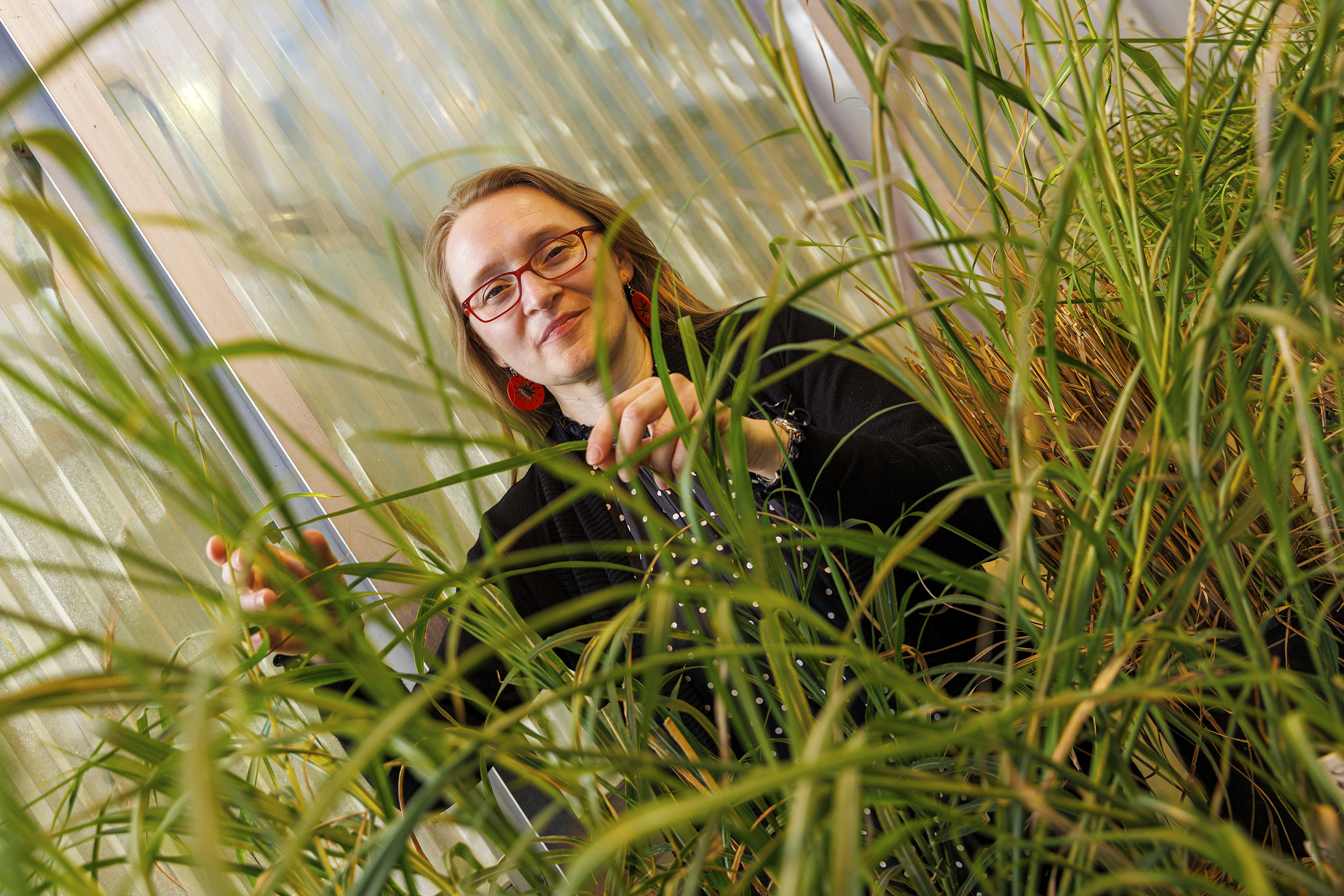
With National Science Foundation funding, a University of Nebraska–Lincoln biochemist is studying the mechanism by which a large, perennial grass is able to survive and thrive at low temperatures. Her findings may shed light on how to maximize the potential of some of its close and economically valuable cousins: corn, sorghum and sugarcane.
Katarzyna Glowacka, assistant professor of biochemistry, is using a five-year, nearly $1.4 million grant from NSF’s Faculty Early Career Development Program to study how a process called non-photochemical quenching, or NPQ — a plant’s first-line defense against damage to its photosynthetic machinery — plays a role in enabling the grass, called miscanthus, to fend off cold-induced damage. She hypothesizes that miscanthus regulates NPQ in a unique way, whereby dark, chilly nights trigger heightened protection against cellular damage.
Developing a fuller picture of this process opens the door to engineering varieties of corn, sorghum and sugarcane that are more resistant to cold temperatures, a trait that is increasingly necessary as weather extremes and water scarcity intensify. Once fortified against cold snaps, these crops could be planted earlier in the spring, enabling them to mature prior to summer droughts. They could also survive in a more diverse range of climates.
“The goal is to understand the protective mechanism and develop some guidance toward developing more chilling-tolerant corn, sugarcane and sorghum,” Glowacka said. “We are asking the question: What is so unusual about this process that it allows miscanthus to survive chilling?”
Miscanthus, corn, sorghum and sugarcane are classified as C4 plants because they all undergo a type of photosynthesis — the ubiquitous process that transforms light, carbon dioxide and water into chemical fuel for plant growth — in which the first carbon compound produced has four carbon atoms.
The majority of C4 plants are highly susceptible to chilling, which limits their geographical distribution, productivity and establishment. This is because the cold temperatures slow the enzymes that drive photosynthesis, causing a buildup of harmful molecules, called reactive oxidative species, in plants’ leaves. These molecules impede growth and damage the photosynthetic mechanism.
Miscanthus avoids this fate — but researchers don’t fully understand why. Glowacka suspects the answer lies in the grass’ unique regulation of NPQ. Though plants need light for photosynthesis, about 75% of the solar energy they’re exposed to during the day is excessive. To ensure the extra light doesn’t damage the plant’s photosynthetic machinery, NPQ converts it into heat and releases it.
Glowacka’s preliminary data indicate that in miscanthus, NPQ is also protective against chilling. The grass appears to regulate NPQ in an unusual way, with dark, cold nights inducing an altered NPQ process that enhances photoprotection. Glowacka aims to develop a more complete picture of the chain of events that triggers this bolstered defense system.
Her research approach is an innovative blend of high-throughput phenotyping, which will allow for the rapid measurement of multiple traits of miscanthus over a period of five years; genetics approaches, which enable an in-depth look at the roles of NPQ-related genes; and redox metabolomics, in partnership with the university’s Redox Biology Center, which enables an analysis of how NPQ impacts the plant as a whole. Glowacka said that, alone, each of these approaches is fairly typical, but it’s novel to unite them in a single project.
For the educational component of the project, she is teaming up with Girl Scouts Spirit of Nebraska to provide summer sessions for 10- to 12-year-old girls focused on hands-on plant sciences activities. She’ll also redesign an undergraduate-level course to focus on science communication skills and incorporate active learning methods.
She and members of her laboratory will engage the public in photosynthesis research through the university’s Sunday with a Scientist program and the Center for Plant Science Innovation’s Fascination of Plants Day.
For these outreach efforts, Glowacka said she draws on her own experiences as a woman in science and a first-generation college student to try to attract more students from underrepresented groups to STEM fields.
“I hope that as a woman — and a woman from abroad — who’s leading a lab, that young students see that they can do it, too,” she said. “And with first-generation students, I want them to see that STEM occupations give them the opportunity to be a citizen of the world. There is no other occupation that gives you the freedom to move from place to place for fellowships and working abroad. I think it’s amazing.”
The National Science Foundation’s CAREER award supports pre-tenure faculty who exemplify the role of teacher-scholars through outstanding research, excellent education and the integration of education and research.








